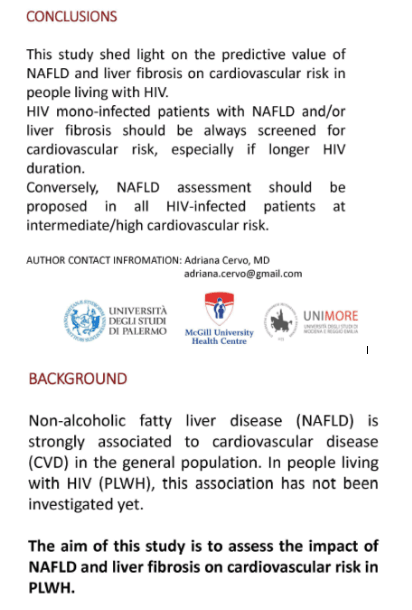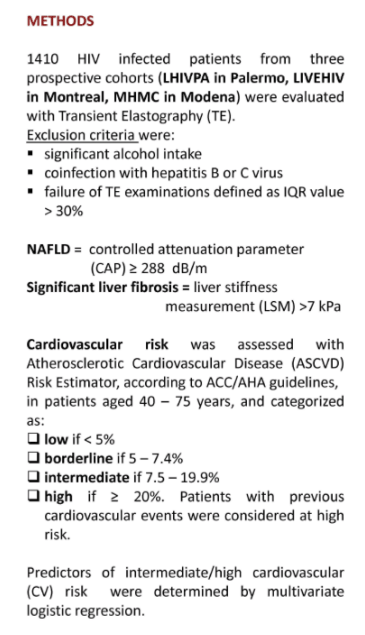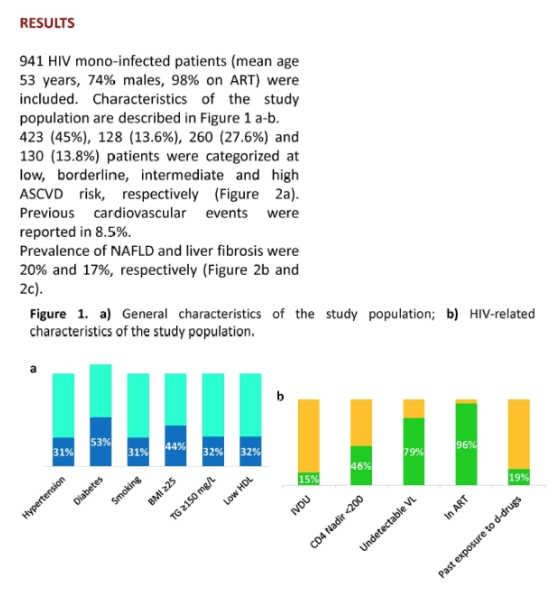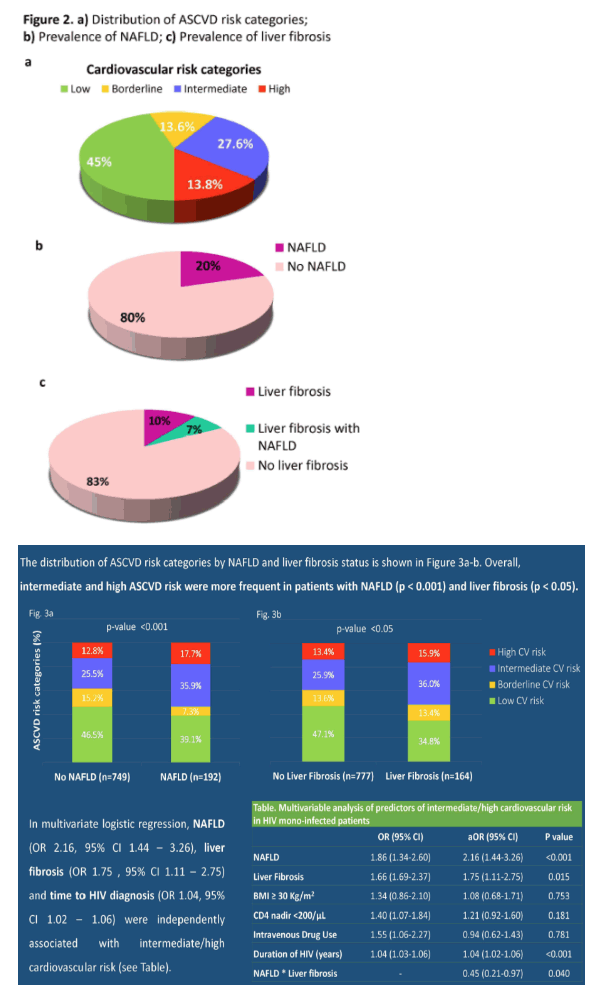 |
 |
 |
| |
NAFLD AND LIVER FIBROSIS PREDICT HIGH CARDIOVASCULAR RISK IN HIV-MONOINFECTED PATIENT
|
| |
| |
CROI 2020
Reported by Jules Levin
Giovanni Mazzola1, Adriana Cervo1, Giovanni Guaraldi2, Thomas Krahn3, Jovana Milic2, Annamaria De Luca4, Claudia Gioè4, Benedetta Romanin4, Marcello Trizzino4
1University Hospital of Palermo, Palermo, Italy,2University of Modena and Reggio Emilia, Modena, Italy,3McGill University Health Centre, Glen site, Montreal, QC, Canada,4University of Palermo, Palermo, Italy
.....80% undetectable VL, 46% cd4 nadir <200, 20% NAFLD, 17% liver fibrosis. 17.7% with NAFLD had high CVD risk, 35.9% intermediate risk vs those with no NAFLD 12.8% with high CVD risk & 25.5% with intermediate risk. those with liver fibrosis ASCVD risk.
program abstract
Non-alcoholic fatty liver disease (NAFLD) is strongly associated to cardiovascular disease (CVD) in the general population. In people living with HIV (PLWH), this association has not been investigated yet. The aim of this study is to assess the impact of NAFLD and liver fibrosis on cardiovascular risk in PLWH.
1410 HIV infected patients from three prospective cohorts (LHIVPA in Palermo, LIVEHIV in Montreal, MHMC in Modena) were evaluated with Transient Elastography (TE). Exclusion criteria were: significant alcohol intake, coinfection with hepatitis B or C virus and failure of TE examinations defined as IQR value > 30%. NAFLD and significant liver fibrosis were defined as controlled attenuation parameter (CAP) ≥ 288 dB/m and as liver stiffness measurement (LSM) > 7 kPa, respectively. Cardiovascular risk was assessed with Atherosclerotic Cardiovascular Disease (ASCVD) Risk Estimator, according to American College of Cardiology, in patients aged 40 – 75 years, and categorized as: low if < 5%, borderline if 5 – 7.4%, intermediate if 7.5 – 19.9% and high if ≥ 20%. Patients with previous cardiovascular events were considered as high risk, regardless of age.
941 HIV mono-infected patients (mean age 53 years, 74% males, 98% on ART) were included. 423 (45%), 128 (13.6%), 260 (27.6%) and 130 (13.8%) patients were categorized as low, borderline, intermediate and high ASCVD risk, respectively. Previous cardiovascular events were found in 8.5%. Prevalence of NAFLD and significant liver fibrosis was 20% and 17%, respectively. The distribution of ASCVD risk classes by NAFLD and fibrosis categories is shown in the Table. Overall, intermediate and high ASCVD risk were more frequent in patients with NAFLD (p < 0.001) and liver fibrosis (p < 0.05). In multivariate logistic regression, NAFLD (OR 2.16, 95% CI 1.44 3.26), liver fibrosis (OR 1.75 , 95% CI 1.11 2.75) and time to HIV diagnosis (OR 1.04, 95% CI 1.02 1.06, p < 0.001) were independently associated with higher ASCVD risk.
Both NAFLD and liver fibrosis are predictors of cardiovascular disease in PLHIV. Prevention of CVD, possibly with lifestyle modifications, should be strengthen in PLHIV with NAFLD, in particular in those with longer HIV duration.




|
| |
|
 |
 |
|
|